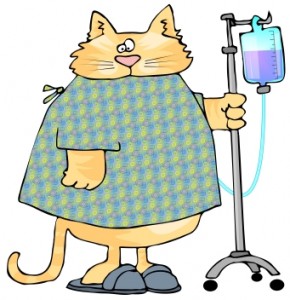 Cats typically have a hate-hate relationship with any strange cat in their presence, yard, or environment. When new cats meet, they fluff up, spit, hiss – more like scream! – and the fur soon goes flying. While the brawl may only last a few seconds, that’s enough time for a few diseases to jump bodies.
Cats typically have a hate-hate relationship with any strange cat in their presence, yard, or environment. When new cats meet, they fluff up, spit, hiss – more like scream! – and the fur soon goes flying. While the brawl may only last a few seconds, that’s enough time for a few diseases to jump bodies.
Feline leukemia (FeLV), feline immunodeficiency virus or cat AIDS (FIV), infectious peritonitis (FIP), or nasty bacterial infections are transmitted from cat to cat in saliva.
Outside cats, particularly unneutered males, love to fight. Most times they will end up with a nasty abscess.
What exactly is an abscess? It’s basically a pocket of pus under the skin. It makes a cat very ill because of the bacteria and toxins it releases into the bloodstream. He is feverish, goes off his food, hides and sleeps a lot.
Treatment for abscesses involves a general anaesthesia, clipping and cleaning the skin, lancing the abscess and flushing all the pus out, placing a drain to allow any new pus to empty, antibiotics and pain relief. Some cats are so sick they need hospitalisation and intravenous fluids for a night or two.
How do we avoid all this??
Desex your cat if he is still entire. Keep him indoors, particularly in the evenings and at night when the brawling usually happens.
Keep other cats off your property. A dog on patrol will soon despatch an intruder. Otherwise keep an eye out for a few evenings and frighten strays off with a loud noise.
Catch the infection as soon as possible. If your cat has been in a fight bring him immediately for an antibiotic shot to discourage the abscess from forming.
Vaccinate your cat against FIV, Feline AIDS. There are three shots in the initial course. A booster at the annual checkup and vaccine review prevents the virus gaining a toe hold.


